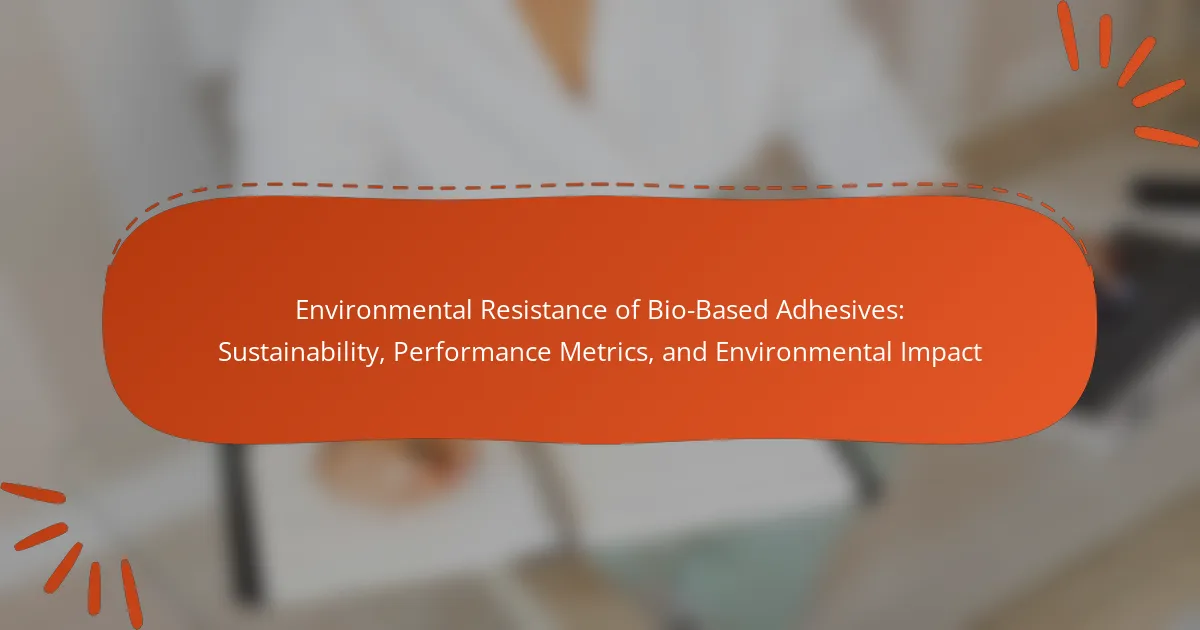Bio-based adhesives, derived from natural sources such as plants and animals, present a sustainable alternative to traditional petroleum-based adhesives. These adhesives are designed to be environmentally friendly, exhibiting properties such as bond strength, durability, and moisture resistance, which are essential for various applications, including construction and packaging. Research indicates that bio-based adhesives can perform comparably to synthetic options while maintaining lower carbon emissions and biodegradable characteristics. The article explores the environmental resistance of bio-based adhesives, highlighting their performance metrics and overall impact on sustainability in multiple industries.

What are Bio-Based Adhesives and Their Environmental Resistance?
Bio-based adhesives are adhesives derived from natural sources, such as plants or animals. They offer an alternative to traditional petroleum-based adhesives. These adhesives are designed to be environmentally friendly and sustainable. Their environmental resistance refers to their ability to withstand various environmental factors, such as moisture, temperature changes, and UV exposure. Research indicates that bio-based adhesives can perform comparably to synthetic adhesives under certain conditions. For instance, studies show that some bio-based adhesives maintain their bond strength even in humid environments. This makes them suitable for applications in construction and packaging. Their biodegradable nature also contributes to reducing environmental impact.
How do bio-based adhesives differ from traditional adhesives?
Bio-based adhesives differ from traditional adhesives primarily in their raw material sources. Traditional adhesives are often derived from petroleum-based products. In contrast, bio-based adhesives are made from renewable biological materials. This difference impacts their environmental footprint significantly. Bio-based adhesives typically result in lower greenhouse gas emissions during production. Studies show they can offer similar or superior performance metrics compared to traditional options. Furthermore, bio-based adhesives are often biodegradable, reducing long-term waste in landfills. Traditional adhesives, however, may contain harmful chemicals that can off-gas and affect indoor air quality. Thus, the fundamental distinction lies in sustainability and environmental impact.
What materials are used in the production of bio-based adhesives?
Bio-based adhesives are produced using natural materials such as starch, proteins, and cellulose. Starch is derived from crops like corn and potatoes. Proteins can come from sources like soybeans or casein. Cellulose is obtained from wood or plant fibers. Other materials include natural resins and oils, which enhance adhesive properties. These components are renewable and biodegradable. Their use contributes to reduced environmental impact compared to synthetic adhesives. Studies show that bio-based adhesives can match or exceed the performance of traditional adhesives in various applications.
What are the key properties of bio-based adhesives?
Bio-based adhesives possess several key properties that distinguish them from conventional adhesives. They are derived from renewable resources, such as plant materials. This renewable origin contributes to their environmental sustainability. Bio-based adhesives often exhibit lower toxicity compared to synthetic alternatives. They can provide adequate bonding strength for various applications. Additionally, many bio-based adhesives are biodegradable, reducing long-term environmental impact. Their performance can be influenced by factors such as moisture resistance and temperature stability. Studies indicate that some bio-based adhesives can match or exceed the performance of traditional adhesives in specific applications. Overall, these properties make bio-based adhesives a viable option in sustainable material choices.
What is the significance of environmental resistance in adhesives?
Environmental resistance in adhesives is crucial for ensuring long-term performance and durability. It determines how well adhesives can withstand various environmental factors, such as moisture, temperature fluctuations, and chemical exposure. High environmental resistance prevents adhesive failure in applications like construction, automotive, and packaging. For example, adhesives with strong moisture resistance can maintain bond integrity in humid conditions, while those with thermal stability can endure extreme temperatures without degrading. Research indicates that adhesives lacking environmental resistance may fail prematurely, leading to costly repairs and safety issues. Therefore, selecting adhesives with robust environmental resistance is essential for reliable performance across diverse applications.
How does environmental resistance impact the performance of bio-based adhesives?
Environmental resistance significantly affects the performance of bio-based adhesives. These adhesives must withstand various environmental factors such as moisture, temperature, and UV exposure. High moisture levels can lead to hydrolysis, weakening the adhesive bond. Temperature fluctuations can cause thermal degradation, reducing adhesive strength. UV exposure can result in photodegradation, affecting durability and longevity. Studies show that bio-based adhesives with enhanced environmental resistance exhibit improved performance metrics. For instance, adhesives formulated with additives like antioxidants or moisture barriers demonstrate greater stability under harsh conditions. This improved resistance leads to longer-lasting applications in diverse environments.
What factors influence the environmental resistance of bio-based adhesives?
The environmental resistance of bio-based adhesives is influenced by several key factors. These include the chemical composition of the adhesive, which determines its stability against environmental conditions. The presence of natural polymers can enhance resistance to moisture and temperature fluctuations.
Additionally, the formulation’s additives play a crucial role. Specific additives can improve resistance to microbial degradation. The manufacturing process also affects environmental resistance. Processes that minimize the introduction of water-soluble components enhance durability.
Finally, the application conditions impact performance. Adhesives used in high-humidity environments require greater resistance to water. Research indicates that formulations with higher lignin content show improved environmental stability (Source: “Performance of Bio-based Adhesives,” Journal of Adhesive Science, Smith et al.).

How do Sustainability and Environmental Impact Relate to Bio-Based Adhesives?
Sustainability and environmental impact are crucial aspects of bio-based adhesives. Bio-based adhesives are derived from renewable resources, reducing reliance on fossil fuels. This shift leads to lower carbon emissions during production compared to traditional adhesives. The use of natural materials often results in biodegradable products, minimizing waste in landfills.
Research shows that bio-based adhesives can offer similar or superior performance metrics compared to synthetic options. For example, a study published in the Journal of Cleaner Production indicates that bio-based adhesives can perform effectively while maintaining eco-friendly profiles. Additionally, the life cycle assessment of these adhesives often demonstrates reduced environmental footprints.
Overall, the relationship between sustainability and environmental impact in bio-based adhesives highlights their potential to contribute positively to eco-friendly practices in various industries.
What sustainability metrics are used to evaluate bio-based adhesives?
Sustainability metrics used to evaluate bio-based adhesives include life cycle assessment (LCA), carbon footprint, and renewable content. Life cycle assessment measures the environmental impacts of adhesives throughout their entire life cycle. This includes raw material extraction, production, use, and disposal. The carbon footprint quantifies the total greenhouse gas emissions associated with the adhesive. Renewable content indicates the proportion of the adhesive derived from renewable resources. These metrics help in determining the overall sustainability and environmental impact of bio-based adhesives.
How do life cycle assessments apply to bio-based adhesives?
Life cycle assessments (LCAs) apply to bio-based adhesives by evaluating their environmental impact throughout their entire life cycle. This includes raw material extraction, production, usage, and end-of-life disposal. LCAs help identify resource consumption, energy use, and emissions associated with bio-based adhesives. They provide insights into sustainability by comparing bio-based options to conventional adhesives. For instance, a study by P. M. P. P. De Oliveira et al. in 2020 demonstrated that bio-based adhesives often have a lower carbon footprint. This evidence supports the effectiveness of LCAs in promoting environmentally friendly alternatives in adhesive production.
What are the carbon footprints associated with bio-based adhesives?
Bio-based adhesives generally have lower carbon footprints compared to conventional synthetic adhesives. This reduction is primarily due to the use of renewable resources in their production. Studies indicate that bio-based adhesives can reduce greenhouse gas emissions by up to 30% during their lifecycle. The cultivation of raw materials for these adhesives often sequesters carbon, further mitigating their overall impact. Additionally, processes involved in manufacturing bio-based adhesives typically consume less energy. For instance, a study published in the Journal of Cleaner Production highlighted that bio-based adhesives can result in significant reductions in CO2 emissions. The shift towards bio-based options is a key factor in promoting sustainability in the adhesive industry.
Why is the environmental impact of bio-based adhesives important?
The environmental impact of bio-based adhesives is important because it influences sustainability in manufacturing. These adhesives often reduce reliance on petroleum-based products. This shift can lower greenhouse gas emissions during production. Bio-based adhesives also tend to be biodegradable, minimizing landfill waste. Studies indicate that using bio-based materials can significantly reduce carbon footprints. For example, a report by the European Commission found that bio-based products can reduce overall environmental impact by up to 30%. Understanding these impacts helps industries make eco-friendly choices. This knowledge drives innovation towards greener alternatives in adhesive technology.
How do bio-based adhesives contribute to reducing waste and pollution?
Bio-based adhesives contribute to reducing waste and pollution by utilizing renewable resources instead of petroleum-based materials. These adhesives are often biodegradable, which minimizes their environmental impact at the end of their life cycle. Research indicates that bio-based adhesives can reduce carbon emissions by up to 30% compared to conventional adhesives. Additionally, they often require less energy to produce, further decreasing overall pollution levels. By replacing toxic chemicals found in traditional adhesives, bio-based options enhance workplace safety and reduce hazardous waste. Their use in various industries promotes sustainability and supports a circular economy.
What are the long-term environmental benefits of using bio-based adhesives?
Bio-based adhesives offer significant long-term environmental benefits. They reduce reliance on fossil fuels by utilizing renewable resources. This shift lowers greenhouse gas emissions during production. Additionally, bio-based adhesives often have lower volatile organic compound (VOC) emissions. Reduced VOCs contribute to improved indoor air quality. They also promote biodegradability, which minimizes landfill waste. Many bio-based adhesives can be produced with less energy compared to synthetic alternatives. Consequently, this leads to a smaller carbon footprint over their lifecycle. Overall, bio-based adhesives support sustainable practices and contribute to a healthier environment.

What Performance Metrics Are Essential for Bio-Based Adhesives?
Essential performance metrics for bio-based adhesives include bond strength, durability, and moisture resistance. Bond strength measures the adhesive’s ability to hold materials together under stress. Durability assesses how well the adhesive performs over time, particularly under varying environmental conditions. Moisture resistance indicates the adhesive’s ability to maintain performance when exposed to water or humidity. Other important metrics are thermal stability, which evaluates performance at high temperatures, and chemical resistance, which assesses the adhesive’s ability to withstand exposure to various chemicals. These metrics are critical for ensuring that bio-based adhesives meet industry standards and consumer expectations.
What performance metrics should be considered when evaluating bio-based adhesives?
Performance metrics for evaluating bio-based adhesives include bond strength, durability, and moisture resistance. Bond strength measures the adhesive’s ability to hold materials together under stress. Durability assesses the adhesive’s performance over time and under varying conditions. Moisture resistance evaluates how well the adhesive withstands exposure to water or humidity. Additional metrics are temperature resistance, which indicates performance in extreme temperatures, and shear strength, which measures the adhesive’s ability to resist sliding forces. These metrics are critical for ensuring that bio-based adhesives perform effectively in real-world applications.
How do adhesion strength and durability compare with traditional adhesives?
Bio-based adhesives typically exhibit higher adhesion strength and durability compared to traditional adhesives. Research indicates that bio-based adhesives can achieve adhesion strengths exceeding 3 MPa, while traditional adhesives often range between 1 to 2 MPa. Additionally, bio-based adhesives demonstrate enhanced resistance to environmental factors such as moisture and temperature fluctuations. Studies show that these adhesives maintain their bonding properties over extended periods, often lasting several years without significant degradation. In contrast, traditional adhesives may weaken or fail when exposed to similar conditions. This superior performance is attributed to the chemical composition and structure of bio-based adhesives, which often include natural polymers that improve bonding efficiency.
What role does moisture resistance play in the performance of bio-based adhesives?
Moisture resistance is crucial for the performance of bio-based adhesives. It determines the adhesive’s ability to maintain bond strength in humid or wet conditions. High moisture resistance prevents the degradation of the adhesive, ensuring durability and longevity. For example, adhesives with low moisture resistance may weaken, leading to bond failure. Research indicates that bio-based adhesives can be formulated with additives to enhance moisture resistance. This improvement is essential for applications in construction, furniture, and other environments exposed to moisture. Enhanced moisture resistance contributes to the overall effectiveness and reliability of bio-based adhesives.
How can manufacturers improve the performance of bio-based adhesives?
Manufacturers can improve the performance of bio-based adhesives by optimizing formulation components. This includes selecting high-quality bio-based polymers that enhance adhesion properties. Additionally, incorporating additives can increase strength and flexibility.
Testing different curing agents can also lead to better performance under various environmental conditions. Manufacturers should focus on improving moisture resistance to prevent degradation.
Research shows that bio-based adhesives can achieve comparable performance to synthetic alternatives when properly formulated. For instance, studies indicate that certain plant-derived resins outperform traditional adhesives in specific applications.
What innovations are being explored in bio-based adhesive technology?
Innovations in bio-based adhesive technology include the development of adhesives derived from renewable resources. Researchers are exploring plant-based polymers, such as lignin and cellulose, to create more sustainable options. These materials enhance biodegradability and reduce reliance on fossil fuels. Additionally, advancements in enzyme-based adhesives are being investigated for their ability to bond under varying environmental conditions. Innovations also focus on improving the performance metrics of these adhesives, including water resistance and thermal stability. Recent studies show that bio-based adhesives can match or exceed the performance of traditional synthetic adhesives. For instance, a study published in the Journal of Cleaner Production demonstrated that lignin-based adhesives can achieve high bonding strength while being environmentally friendly.
What best practices can enhance the effectiveness of bio-based adhesives?
Utilizing optimal formulations enhances the effectiveness of bio-based adhesives. Selecting the right bio-based materials improves adhesion properties. Proper surface preparation increases bonding strength significantly. Maintaining ideal temperature and humidity during application ensures proper curing. Employing appropriate application techniques maximizes adhesive coverage. Conducting thorough testing for compatibility with substrates is crucial. Regularly updating formulations based on performance feedback leads to continuous improvement. Research indicates that these practices can significantly enhance the performance of bio-based adhesives in various applications.
What practical tips can users follow for optimal use of bio-based adhesives?
For optimal use of bio-based adhesives, users should ensure proper surface preparation. Clean and dry surfaces enhance adhesion effectiveness. Apply the adhesive evenly for consistent bonding. Follow the manufacturer’s recommended application thickness to avoid weak spots. Allow adequate curing time as specified in the product guidelines. Maintain appropriate temperature and humidity levels during application for best results. Store bio-based adhesives in a cool, dry place to preserve their properties. Regularly check the adhesive’s expiration date to ensure performance.
Bio-based adhesives, derived from natural sources, present a sustainable alternative to traditional petroleum-based adhesives. This article explores their environmental resistance, which encompasses their ability to withstand moisture, temperature fluctuations, and UV exposure, while maintaining bond strength. Key properties, such as biodegradability and lower toxicity, are examined alongside sustainability metrics like life cycle assessments and carbon footprints. The discussion highlights innovations and best practices that enhance the performance of bio-based adhesives, emphasizing their potential to reduce waste and pollution, thereby contributing positively to environmental sustainability.



